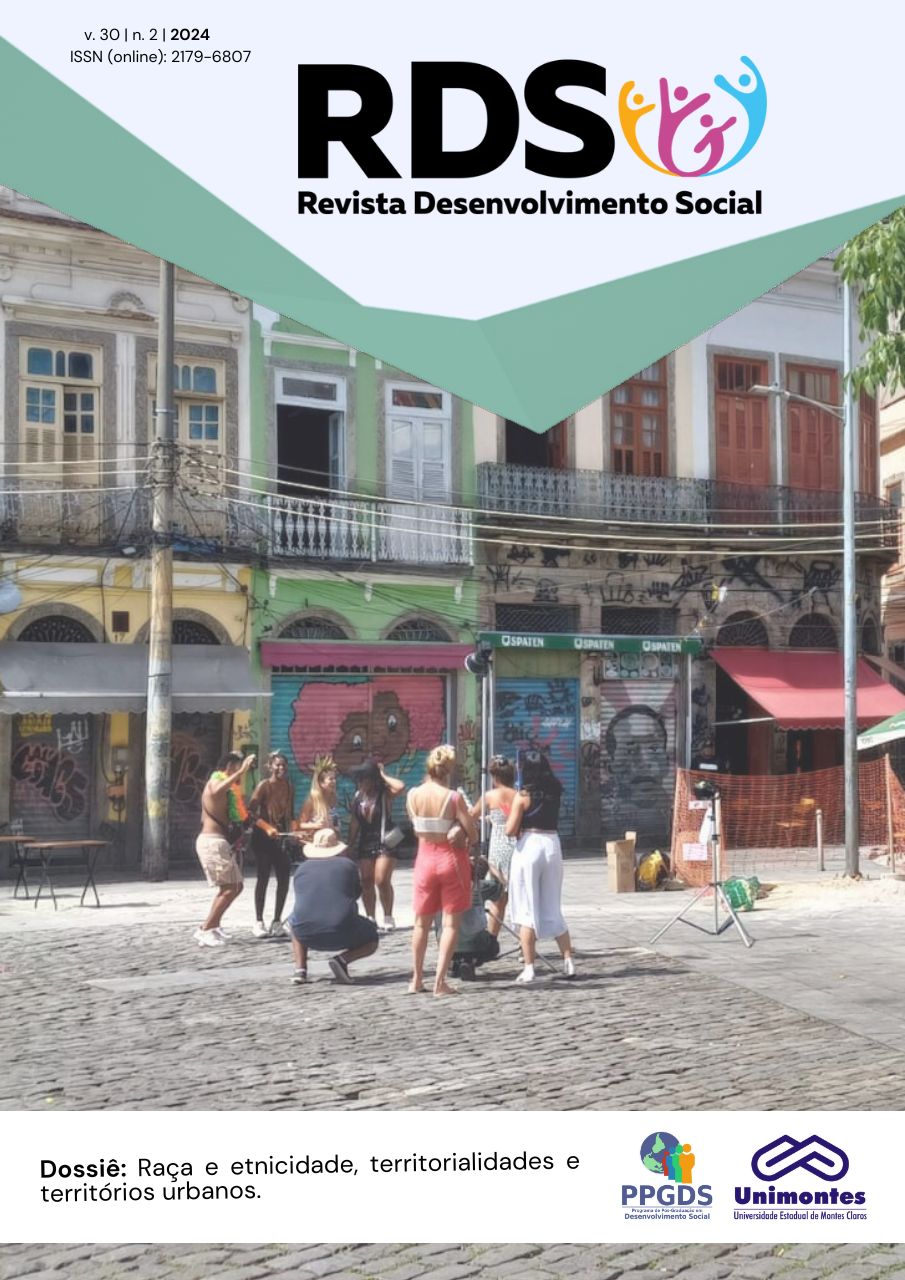TERRITÓRIOS DO AMANHÃ: O QUILOMBO DO MOLA, AMAZÔNIA, BRASIL
TOMORROW’S TERRITORY: THE QUILOMBO OF MOLA, AMAZON, BRAZIL
DOI:
https://doi.org/10.46551/issn2179-6807v30n2p92-122Palabras clave:
Arqueologia digital, Quilombos amazônicos, Memória colaborativa, Patrimônio cultural, Cartografia afetivaResumen
La investigación propone expandir el territorio quilombola al entorno digital mediante la creación de un archivo de memoria colaborativa y un territorio virtual que actúe como una extensión protética del espacio físico. Prácticas como la modelación electrónica y la cartografía afectiva apoyan la preservación y comunicación del legado histórico y contemporáneo de las comunidades quilombolas amazónicas, promoviendo la continuidad cultural en nuevas espacialidades. Este estudio explora las interacciones materiales y no materiales en un quilombo amazónico, empleando enfoques arqueológicos y digitales para comprender la construcción de identidades y la preservación del patrimonio quilombola. Utilizando la observación en campo y el análisis de materiales, examinamos fragmentos de cerámica, latas de aluminio, chancletas y otros artefactos cotidianos, destacando la importancia de una arqueología del presente y del futuro. Concluimos que la superposición de temporalidades y la transposición de elementos físicos al ámbito virtual son cruciales en la reinterpretación y gestión del patrimonio cultural, garantizando representatividad y continuidad identitaria en el contexto digital.
Descargas
Citas
A história do Quilombo do Mola. 31 maio 2018. Disponível em: <https://www.youtube.com/watch?v=5lw98mMXPn8>. Acesso em: 2 nov. 2024
AZUMA, R. T. A Survey of Augmented Reality. Presence: Teleoperators and Virtual Environments, v. 6, n. 4, p. 355–385, ago. 1997.
BOYD, DANAH M.; ELLISON, N. B. Social network sites: Definition, history, and scholarship. Journal of Computer-Mediated Communication, v. 13, n. 1, p. 210–230, 2007.
BRITTON, C. Edouard Glissant and postcolonial theory: strategies of language and resistance. [s.l.] Charlottesville, Va.: University Press of Virginia, 1999.
CASTELLS, M. The Rise of the Network Society. [s.l.] John Wiley & Sons, 2011.
CASTELLS, M. Communication Power. [s.l.] OUP Oxford, 2013.
CRAMPTON, J. W. Mapping: a critical introduction to cartography and GIS. [s.l.] Malden, Mass: Wiley-Blackwell, 2010.
DELEUZE, G. et al. A Thousand Plateaus: Capitalism and Schizophrenia. Journal of Interdisciplinary History, v. 19, n. 4, p. 657, 1989.
DODGE, M.; KITCHIN, R.; PERKINS, C. (EDS.). Rethinking Maps: New Frontiers in Cartographic Theory. London: Routledge, 2011.
FORTE, M. Introduction to cyber-archaeology. Em: Cyber-Archaeology, BAR International Series. [s.l: s.n.]. v. 2177p. 9–13.
FRISCHER, B.; DAKOURI-HILD, A. (EDS.). Beyond Illustration: 2D and 3D Digital Technologies as Tools for Discovery in Archaeology. Ann Arbor, MI: University of Michigan Press, 2008.
GILLINGS, M. The Real, the Virtually Real, and the Hyperreal: The Role of VR in Archaeology. Em: Envisioning the Past. [s.l.] John Wiley & Sons, Ltd, 2005. p. 223–239.
GLISSANT, É. Poética da relação. [s.l.] Bazar do Tempo, 2021.
GONZÁLEZ‐RUIBAL, A. Time to Destroy: An Archaeology of Supermodernity. Current Anthropology, v. 49, n. 2, p. 247–279, abr. 2008.
HALL, S.; GAY, P. DU. Questions of Cultural Identity: SAGE Publications. [s.l.] SAGE, 1996.
HARLEY, J. B. Deconstructing the map. Passages, 1992.
HARRISON, R. Surface assemblages. Towards an archaeology in and of the present. Archaeological Dialogues, v. 18, n. 2, p. 141–161, dez. 2011.
HARVEY, D. Spaces of Capital: Towards a Critical Geography. New York: Routledge, 2001.
JENKINS, H. Convergence Culture: Where Old and New Media Collide. [s.l.] NYU Press, 2006.
KAPELL, M. W.; ELLIOTT, A. B. R. Playing with the Past: Digital Games and the Simulation of History. [s.l.] Bloomsbury Publishing USA, 2013.
KETELAAR, F.; MCKEMMISH, S.; GILLILAND-SWETLAND, A. J. 2024 “Communities of Memory”: Pluralising Archival Research and Education Agendas.
KOLLER, D.; FRISCHER, B.; HUMPHREYS, G. Research challenges for digital archives of 3D cultural heritage models. J. Comput. Cult. Herit., v. 2, n. 3, p. 7:1-7:17, 5 jan. 2010.
LEFEBVRE, H. La production de l’espace. L’Homme et la société, v. 31, n. 1, p. 15–32, 1974.
MAFFESOLI, M. The Time of the Tribes: The Decline of Individualism in Mass Society. London: SAGE Publications Ltd, 1996.
MIGNOLO, W. D. The Darker Side of Western Modernity: Global Futures, Decolonial Options. Illustrated edição ed. Durham: Duke University Press, 2011.
Minor Transnationalism. [s.l.] Duke University Press, 2005.
NORA, P. Between Memory and History: Les Lieux de Mémoire. Representations, n. 26, p. 7–24, 1989.
PINTO, B. C. DE M. Escravidão, Fuga e a Memória de Quilombos na Região do Tocantins. Projeto História: Revista do Programa de Estudos Pós-Graduados de História, v. 22, 2001.
PINTO, B. C. DE M. História, Memória e Poder Feminino em Povoados Amazônicos. XI Encontro Nacional de História Oral. Anais.2012.
PINTO, B. C. DE M. Mulheres Negras Rurais: Resistência e Luta por Sobrevivência na Região do Tocantins (PA). XXVI Simpósio Nacional de História. Anais...2016.
REILLY, P. Towards a virtual archaeology. 1 jan. 1990.
RIVA, G.; ANOLLI, L. (EDS.). From communication to presence: cognition, emotions and culture towards the ultimate communicative experience: Festschrift in honor of Luigi Anolli. Amsterdam; Oxford: IOS Press, 2006.
SALLES, V. O negro no Pará sob o regime da escravidão. 3a edição revista e ampliada ed. Belém [Brazil]: Instituto de Artes do Pará, Programa Raízes, 2005.
SCHMALSTIEG, D.; HOLLERER, T. Augmented Reality: Principles and Practice. Illustrated edição ed. Boston: Addison-Wesley Professional, 2015.
SCHOFIELD, J. Combat archaeology: material culture and modern conflict. [s.l: s.n.].
SCHUMAHER, S.; JUNIOR, E. G. Lélia Gonzalez (1935 -1994). Memória Feminista Antirracista, 2024.
SHIELDS, R. Lefebvre, Love and Struggle: Spatial Dialectics. London: Routledge, 1998.
SMITH, P. L. T. Decolonizing Methodologies: Research and Indigenous Peoples. [s.l.] Zed Books Ltd., 2021.
Publicado
Cómo citar
Número
Sección
Categorías
Licencia
Derechos de autor 2025 Diogo Menezes Costa

Esta obra está bajo una licencia internacional Creative Commons Atribución-NoComercial-SinDerivadas 4.0.
Esta licença permite que outros(as) façam download do trabalho e o compartilhe desde que atribuam crédito ao autor(a), mas sem que possam alterá-lo de nenhuma forma ou utilizá-lo para fins comerciais.












.png)
.png)




.png)









